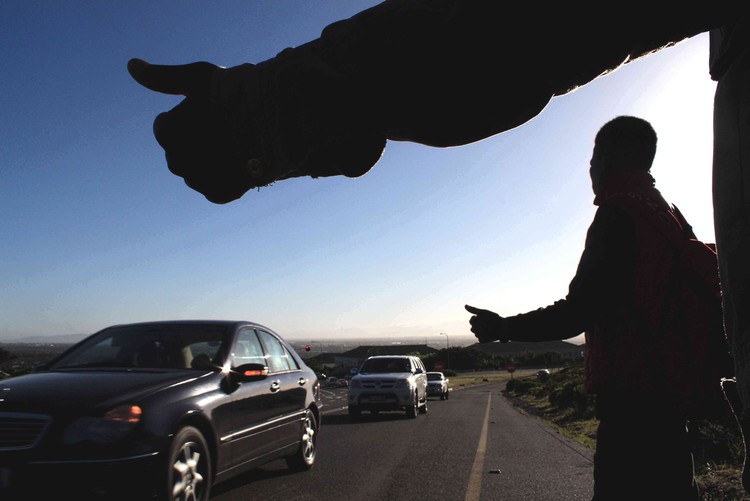
Learners from Westlake township hitch a ride to their school in Masiphumelele on Cape Town’s Ou Kaapse Weg. Archive photo: Masixole Feni
18 January 2019
As the new school year gets underway, thousands of learners still battle to get to school.
According to a briefing to the parliamentary committee on appropriations in March last year, over 570,000 learners needed transport to their nearest school in 2017-2018. But just shy of 470,000 learners were actually transported, with KwaZulu-Natal transporting only about half of those who needed it.
The national policy on scholar transport, published by the Department of Transport and the Department of Basic Education in 2015, allows each province to determine who should get learner transport. Beneficiaries must be “needy learners from grade R to 12, learners with disabilities must be prioritised, and no learner transport should be provided in areas with public transport to “avoid duplication of services and resources”. The policy also sets out transport safety regulations.
But implementation of the policy has been slowed by problems of funding and of location of responsibility.
Provinces have considerable discretion over the allocation of the funds they get from the National Treasury through the budget, and funding of scholar transport has been inconsistent, though total spending has increased. National spending on learner transport over the past two years rose from R2.3 billion in the 2015-2016 financial year to R2.6 billion in 2016/2017. In 2018, over R3 billion was allocated for learner transport.
A further problem is who takes responsibility for learner transport in each province - the education or transport departments.
In November GroundUp reported on Cape Winelands district learners who, supported by Women on Farms, demanded better transport and changes to what is called the five kilometre rule. This rule is in most of the provinces’ learner transport policies, and states that learners who live more than 5km from the nearest school are entitled to transport from the province if public transport is not available.
In the Western Cape, Women on Farms pushed for the education department to measure the 5km from learners’ homes rather than from the farm gate, as many learners still have long distances to walk from the gate to their home.
The Western Cape Education Department agreed to review the policy but when GroundUp asked about this, communications director Millicent Merton said this was an “internal review” and provided no further detail.
Equal Education (EE) has also been pushing for more comprehensive learner transport. In 2017, EE won a major victory by securing learner transport for twelve schools in Nquthu after taking the KZN departments of education and transport to court. This court case also resulted in a commitment from the KZN education department to file a report to the court on plans to improve learner transport. In its report the department said that though the province’s plan to transport all learners who live 3km or more from the nearest school was “laudable”, the budget made this difficult.
The KZN department promised to revise the policy by December 2018 and EE, whom the department views as a “meaningful role player” in this revision, is awaiting this response.
EE is now pushing for the establishment of a conditional grant for learner transport from the education department and Treasury. Money from this grant would be dedicated to scholar transport programmes only. In 2018, both the Basic Education Minister, Angie Motshekga, and the Director General, Mathanzima Mweli, welcomed this idea, but the grant for scholar transport was not introduced in the 2018 budget.
Demichelle Petherbridge of the Equal Education Law Centre told GroundUp that a conditional grant could help solve the issue of insufficient funding. Currently, she said, funds paid to the provinces from the National Treasury are often re-allocated to other needs, “leaving insufficient funds for scholar transport”.
We have not attempted to verify the accuracy of the sources we’ve used below. Also, in contrast to our usual policy, we have not rounded numbers.
Location of responsibility: Department of Education
Who qualifies at what distance: 5km, provided there is no nearer school
Location of responsibility: Department of Education
Who qualifies at what distance: 5km
How many learners benefit: In 2018, 61,558 learners across 567 routes
Sources: Correspondence with the department of Education of the Western Cape, dated January 11, 2019 and this document
Location of responsibility: Community Safety and Transport Management.
Who qualifies at what distance: 5km
Location of responsibility: Public Works, Roads and Transport
Who qualifies at what distance: 5km
Location of responsibility: Eastern Cape Department of Transport. The department created an in-house Scholar Transport Project Management Unit. Learner transport is coordinated and identified through local bus and minibus taxis.
Who qualifies at what distance: Not clear, department refers to 3km and 5km
How many learners benefit: 77,774 learners daily, or 63% of those who need it
Location of responsibility: Department of Education
Who qualifies at what distance: 5km
How many learners benefit: 24,659 out of 29,115 who need it
Location of responsibility: Department of Education
Who qualifies at what distance: 3km. The department prioritises “learners that travel the longest distance to the nearest grade appropriate school”.
Location of Responsibility: Department of Transport
Who qualifies at what distance: 5km
How many learners benefit: in 2017-2018, 10,637 learners were transported, exceeding the expected 9,868 target.
Location of Responsibility: Department of Education
Who benefits at what distance: 5km